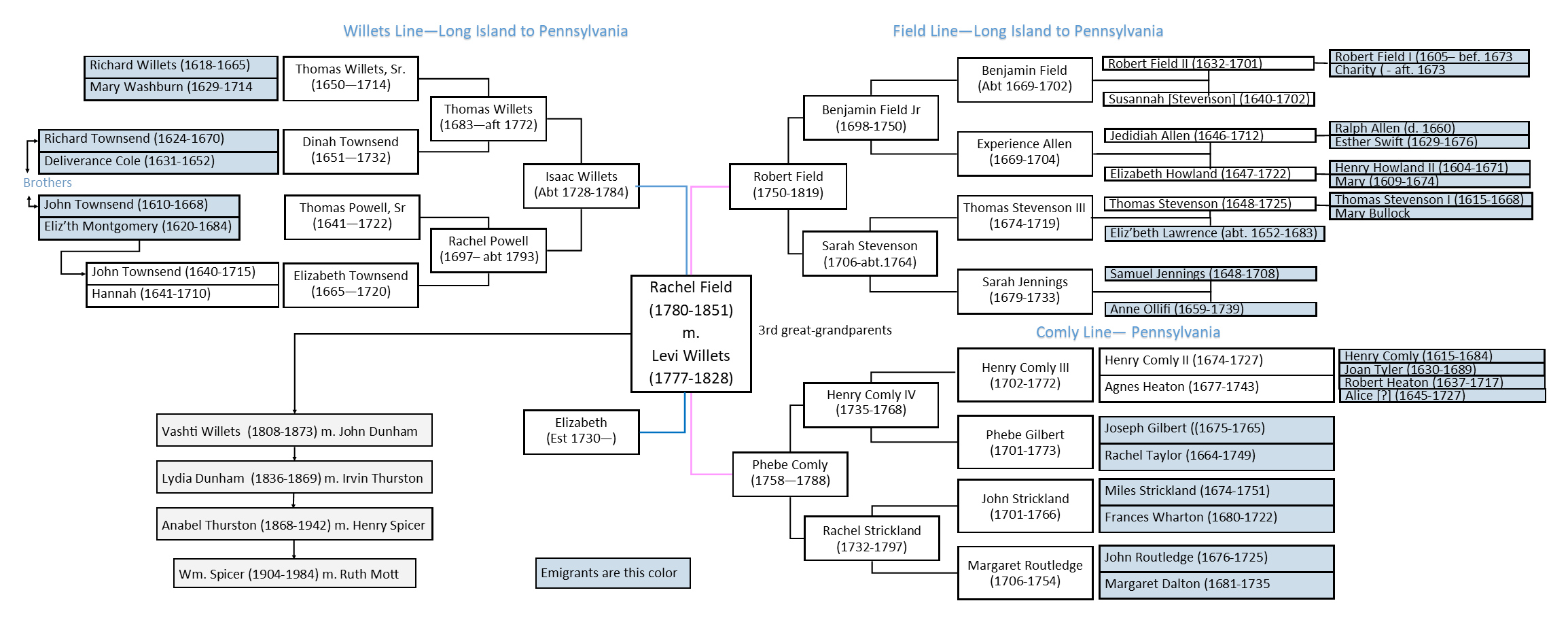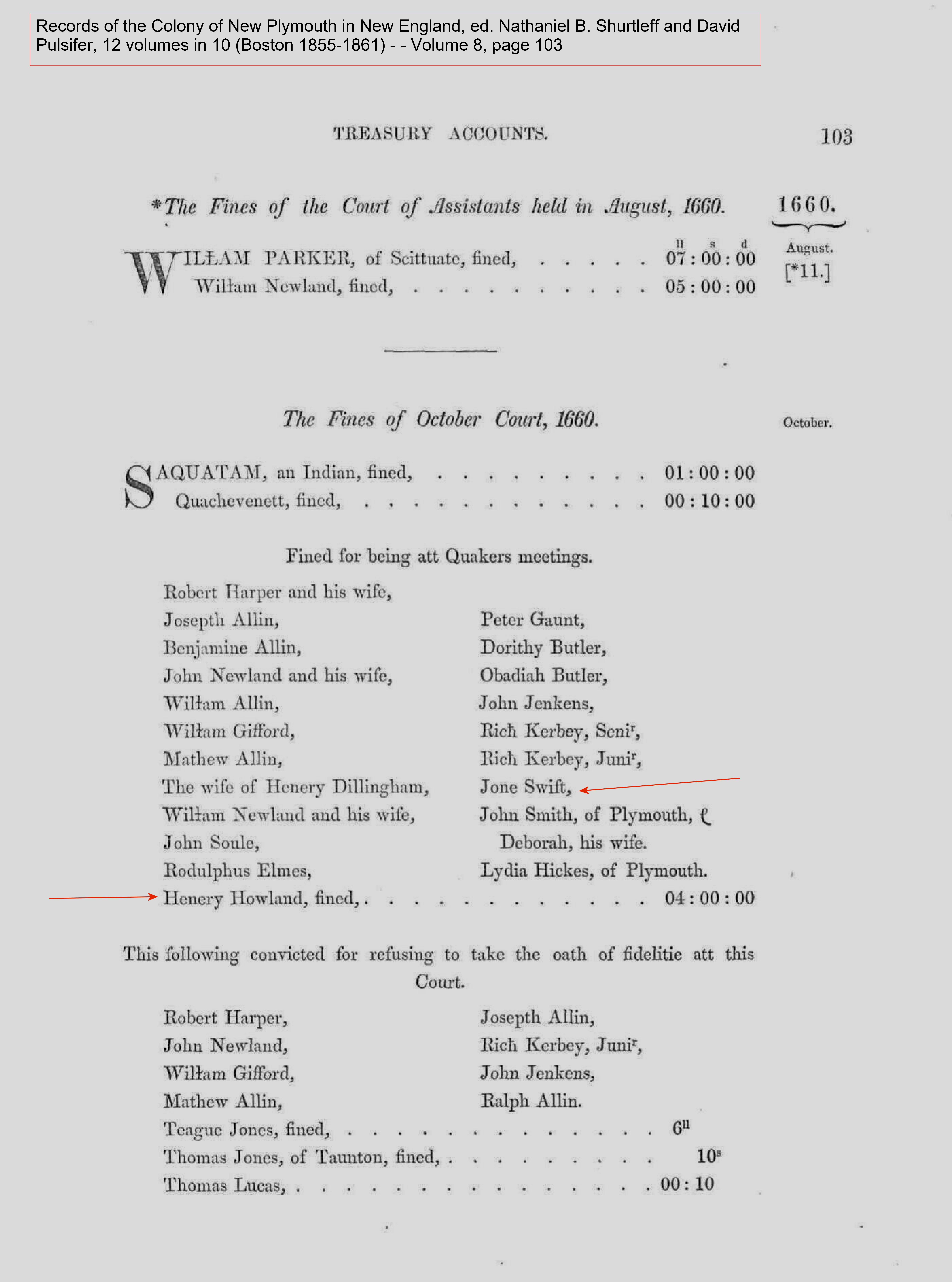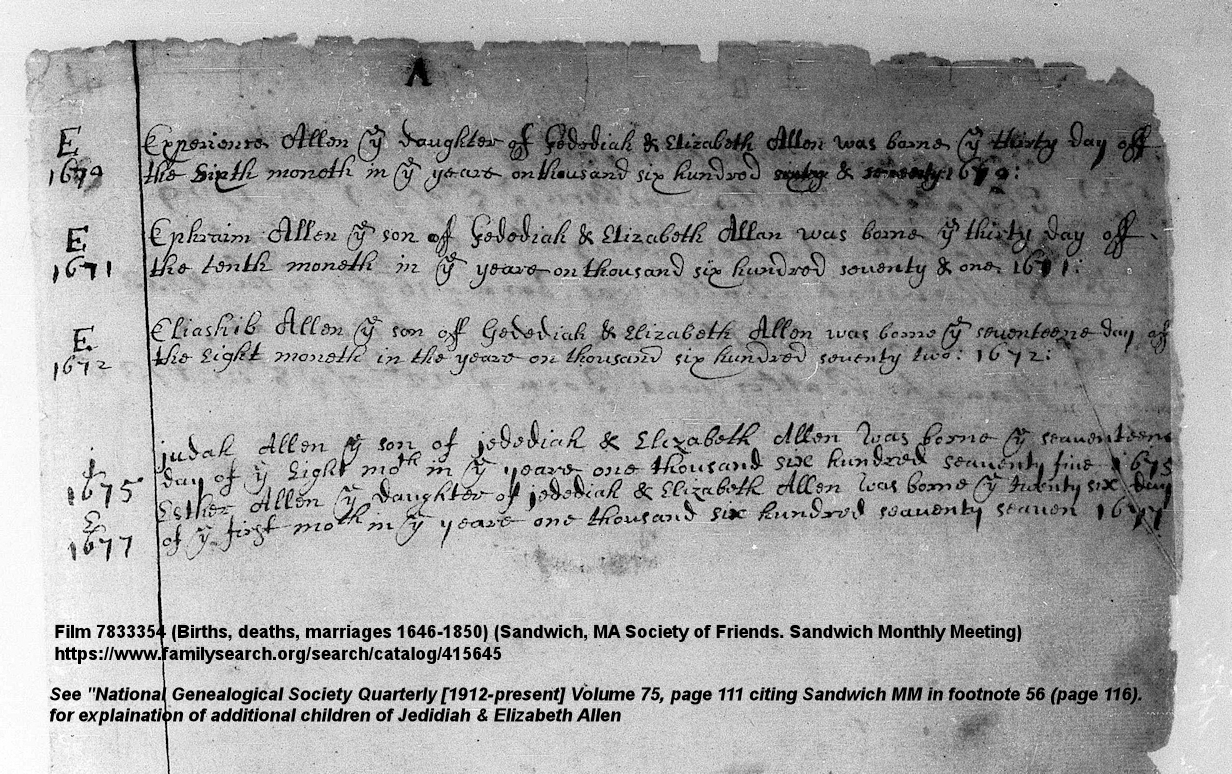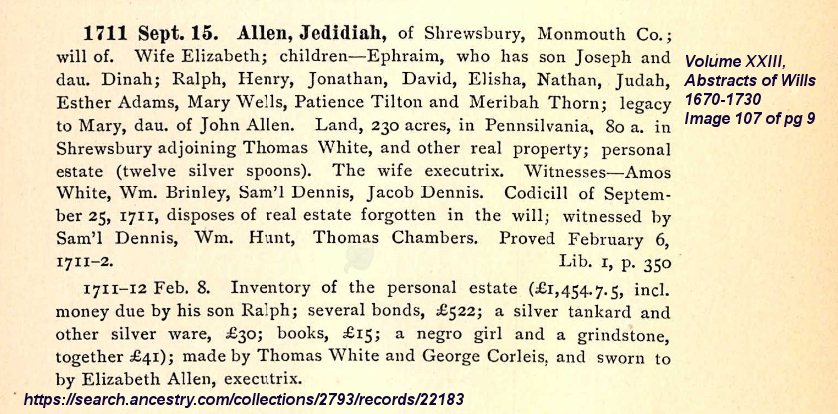My Quaker Ancestors
An Introduction
and with my earliest Quaker ancestors,
Ralph Allen and Henry Howland
Rachel Field (1780-1851),
my third great-grandmother, is the main focus of this mini-website and family history in my Genealogy pages.
It wasn’t until I started digging into some lines in my father’s ancestry that I discovered how deep my Quaker roots were in the 17th and 18th century. These five pages explore those ancestors, both paternal, maternal, and geographically as they began in the Plymouth Colony, on Long Island, and in Pennsylvania, and then to Indiana where Rachel Field died, perhaps the last of my ancestors who had connection to the Society of Friends.
Introduction
Much has been written about the origins and rise of The Society of Friends in England under the influence of George Fox in the period of the English Civil War of the mid-17th century. Quakers were dissatisfied with the teachings of the Church of England as well with the Puritans who dominated the Massachusetts Bay Colony. Keep in mind that Quakerism, as a persecuted sect, really took hold in England about 1650, some thirty years after the Puritans landed in Plymouth. I’ve made little or no attempt yet to trace ancestors in England; my American Quaker ancestors were either born in America or came as emigrants.
A number of lines of Quakers funneled into my ancestry, from the Allens and Howlands in Massachusetts who rebelled against Puritans, the Field and Powell emigrants to Rhode Island and Connecticut who established Quaker Meetings on Long Island, and, as well, some immigrant families who followed William Penn into Pennsylvania directly from England in the 1680s and established Quaker Meetings in and around Philadelphia.
This “funneling” led to my third great-grandmother, Rachel Field (1780-1851) who was perhaps the last in my ancestry to have formal connection with the Quakers. All of her American ancestors, and those of her husband Levi Willets, were, or became, Quakers.
To demonstrate this is a challenge since the lines are paternal, maternal, and geographically mixed. The following chart, and map, hopefully contribute to that understanding. The four pages included on this “mini-website” cover three main groups and include more maps and some reduction of the main chart. They also include sources used and for further reference.
Master chart
Clicking on the image will enlarge it. Once enlarged, another click allows panning.

Maps
This mini-website has many maps. The one here is an overview of the “funneling” movement of the lines eventually to Catawissa in Pennsylvania. The movement to Indiana by Rachel and her husband Levi is on the Willets page, as are locations in and around Catawissa. The Willets page also has a map of Quaker Meeting locations on Long Island. One map stands alone on its own page: Monthly Meetings North of Philadelphia attended by my Quaker Ancestors. That page also has some of those that are on the abovementioned pages.
My own descent from these 3rd great-grandparents is as follows, but is not the subject of these particular pages:
Rachel Field and Levi Willets

Vashti Willets and John Dunham

Lydia Dunham and Irvin Thurston

Anabel Thurston and Henry Spicer

William J. Spicer and Ruth Mott (my parents)
The Allens and Howlands
Perhaps the earliest Quakers in my ancestry are Henry Howland, Ralph Allen junior, and Ralph’s mother-in-law, Joan Swift. They, in the 1650s, appear on the Plymouth court records as being fined for refusing the “oath of fidelitie,” and attending Quaker meetings which was forbidden. Howland lived in Duxbury north of Plymouth, and the Allens met with Quakers in what is the first Quaker Meeting house in America, in Sandwich, Massachusetts. The website of the Sandwich Monthly Meeting at capecodquakers.org has a tremendous set of pages on its history.
The map locating Duxbury and Sandwich on a current map includes the early 1677 Hubbard Map of New England in which North is to the right. Boston is circled. That's the "leg" of Cape Cod in the lower left. The history of the "Hubbard Map" and a larger image to view is at Massachusetts Historical Society.
The Allens: Ralph senior and Ralph junior
The Allens, Ralph senior and junior, appear quite frequently in the Colony’s records as do George, Joseph, Matthew, and William Allen. For many decades the two Ralphs were entangled, considered to be father and son. They were not. Charles Anderson, in The Great Migration article on George Allen, provides perhaps the definitive account, concluding that if the two were related, it was not as father and son. That conclusion, and the evidence provided, appear in Appendix One; it is not my intention here to review. Ralph junior, however related to the other New England Allens, was my 9th great-grandfather. As Anderson concludes, his mother-in-law was the Joan Swift who was fined in 1660 for attending Quaker meetings, and named her grandson Jedidiah and his sister Experience in her 1662 will. It is her will, and the references to Ralph senior and junior in the records which include their different occupations, which form the basis of the conclusion in the Great Migration article. The entire section on Ralph in the article is provided here in Appendix One.
Jedidiah was one of at least three, possibly four children of Ralph Allen junior.
Ralph’s widow Esther, remarried Henry Bull, a prominent Quaker who lived in Newport, Rhode Island but returned to Sandwich to claim the widow Esther as his bride in February of 1664. Bull became a Quaker by the time he married Esther, who died in 1676 in Newport, Rhode Island.
Court fines of October, 1660; one of many pages on which Allens and Howlands appear fined or even imprisoned.

Jedidiah Allen and his wife Experience Howland.
Rachel Field's descent from Jedidiah Allen: Rachel, Robert4, Benjamin Field, Jr.3, Experience2 & Benjamin Field Sr., Jedidiah Allen.

Sandwich Monthly Meeting register.
Ralph junior's son Jedidiah Allen, married Henry Howland’s daughter Elizabeth. Their family of thirteen children began in Sandwich, Massachusetts where five of their children are named in the Sandwich Monthly Meeting registers, including their first-born Experience Allen. The rest of the children were born in Sandwich or New Jersey although it has been impossible to determine. They moved, in the early 1680s, to Shrewsbury, New Jersey where Jedidiah Allen is on record as receiving a patent on 410 acres of land in Monmouth County. Wakefield and Sherman wrote, “For several years he represented Shrewsbury in the East Jersey Assembly, starting in 1686, and he was a member of the first Colonial Assembly after the consolidation of East and West Jersey in 1703. In August 1700 and March 1701 Jedidiah Allen served as a justice in the Court of Sessions of Monmouth County at Middletown.” The family is discussed extensively in the Wakefield and Sherman article as well as Charles Gardener’s article in the The Genealogical Magazine of New Jersey. (See sources below.)

Jedidiah’s will of September 15, 1711 and proved February 8, 1711/12 names all thirteen children save Experience who had pre-deceased him in 1704. Neither her children nor her husband Benjamin Field are named. It was a substantial estate of acreage and close to what would be half a million dollars in today’s money, and which included a “negro girl and a grindstone, together £41.”
Henry Howland (1604-1671)
Descent of Rachel Field from Henry Howland: Rachel6, Robert5, Benjamin Jr.4, Experience3 & Benjamin Field Sr., Elizabeth2 & Jedidiah Allen, Henry Howland (Emigrant).
Jedidiah Allen’s father-in-law was a perpetual thorn in the Puritan side beginning at least in 1657 when he was summoned to appear in court for entertaining a Quaker meeting in his house. He was fined for that, as he was fined in succeeding years for the same offence, and in 1659 was disenfranchised from the Colony. He was fined in October of 1660, his name appearing with the aforementioned Joan Swift, Jedidiah Allen’s grandmother-in-law.
Previous to his conversion to his Quaker faith, he had been a respected member of the Colony, serving on the both the petit jury in 1636, the Grand jury in 1645, and holding the office of surveyor of highways. He had come to America with his brother Arthur about 1632, following their brother John Howland, who is “famous" for being the Mayflower passenger who fell overboard to be rescued by his shipmates. He is discussed thoroughly in the 1987 article in the National Genelogical Society Quartery, Henry Howland of Duxbury, Massachusetts, 1633, His Children and His Grandchildren.
Eight children are attributed to him with his wife Mary, whose maiden name has sometimes, without evidence, given as Newland; there are Newlands named, however, in the Court records as having received fines for attending Quaker meetings, but there is no parentage record for Mary. The order in which the eight children were born is generally agreed upon, although there is some debate. No debate, however, that they had a daughter Elizabeth who married Jedidiah Allen; she is named in Henry’s 1670 will as having been bequeathed “one cow” and in her mother Mary’s 1674 will “to my daughter Elizabeth Allin” £1.
Sources
While the Great Migration article on Ralph Allen is Appendix One, I have copies of the other articles and am willing to share.
- Anderson, Robert C., and Sanborn, George and Melinde, The Great Migration: Immigrants to New England, 1634-1635, Vol. 1: A-B, page 27 begins article on George Allen, pages 33-34 for section on the two Ralph Allens. (See Appendix One for pages 33-34)
- Anderson, Robert Charles. The Great Migration Begins: Immigrants to New England, 1620-1633, Volume 2, pages 1016-1019 for Henry Howland, pages 1020-1024 for his brother John Howland.
- Robert S. Wakefield, F.A.S.G., and Robert M. Sherman, F.A.S.G., “Henry Howland of Duxbury, Massachusetts, 1633, His Children and His Grandchildren,” (National Genealogical Society Quarterly, Vol. 75, Nos. 2, 3, and 4 (June, September, December 1987), beginning page 105, 216, and 278 respectively.) Perhaps the most recent definitive article on Henry Howland.
- Shurtleff and Pulsifer, editors, Records of the Colony of New Plymouth, in New England (12 volumes, Boston MA: William White, 1855-1861) available at FamilySearch.org: https://www.familysearch.org/search/catalog/344454 Specific citations in the above articles. (PCR)
- Gardner, Charles Carroll, “Ralph Allen of Sandwich” in “The Genealogical Magazine of New Jersey,” (Vol. 16, No. 3 (July, 1941), Pages 49ff. As part of his “A Genealogical Dictionary of New Jersey.” Some errors pointed out by Wakefield, but otherwise an important resource.
- Howland resources: much has been written about Henry Howland’s brother John, a Mayflower passenger: see his Wikipedia article at https://en.wikipedia.org/wiki/John_Howland or the Mayflower History page at http://mayflowerhistory.com/howland
Find-a-Grave Memorials
Deaths before about 1850 are mostly not memorialized and many memorials contain questionable information, but they can often provide valuable leads. The following people discussed on this page have memorials created by researchers without finding headstones in most cases and have surprisingly good information. Links open in a new window or tab.
Footnotes: